Strategic Marketing Management Report: Muji Cafe Analysis
VerifiedAdded on 2023/06/04
|16
|5769
|126
Report
AI Summary
This report offers a comprehensive analysis of Muji Cafe's strategic marketing management, focusing on its operations in Singapore. It begins with an introduction to strategic marketing management, discussing key concepts and their application. The report then provides an overview of Muji Cafe, including its product offerings and target market. A critical analysis of the cafe's market position, growth trends, and consumer behavior is presented, alongside an identification of its key competitors. The report delves into the challenges faced by Muji Cafe in the Singapore market, such as competition and consumer preferences. Finally, the report recommends an extended marketing mix (7 Ps) to enhance Muji Cafe's strategic approach, covering product, price, place, promotion, people, process, and physical evidence. This report aims to provide a detailed understanding of Muji Cafe's marketing strategies and offer actionable recommendations for improvement.
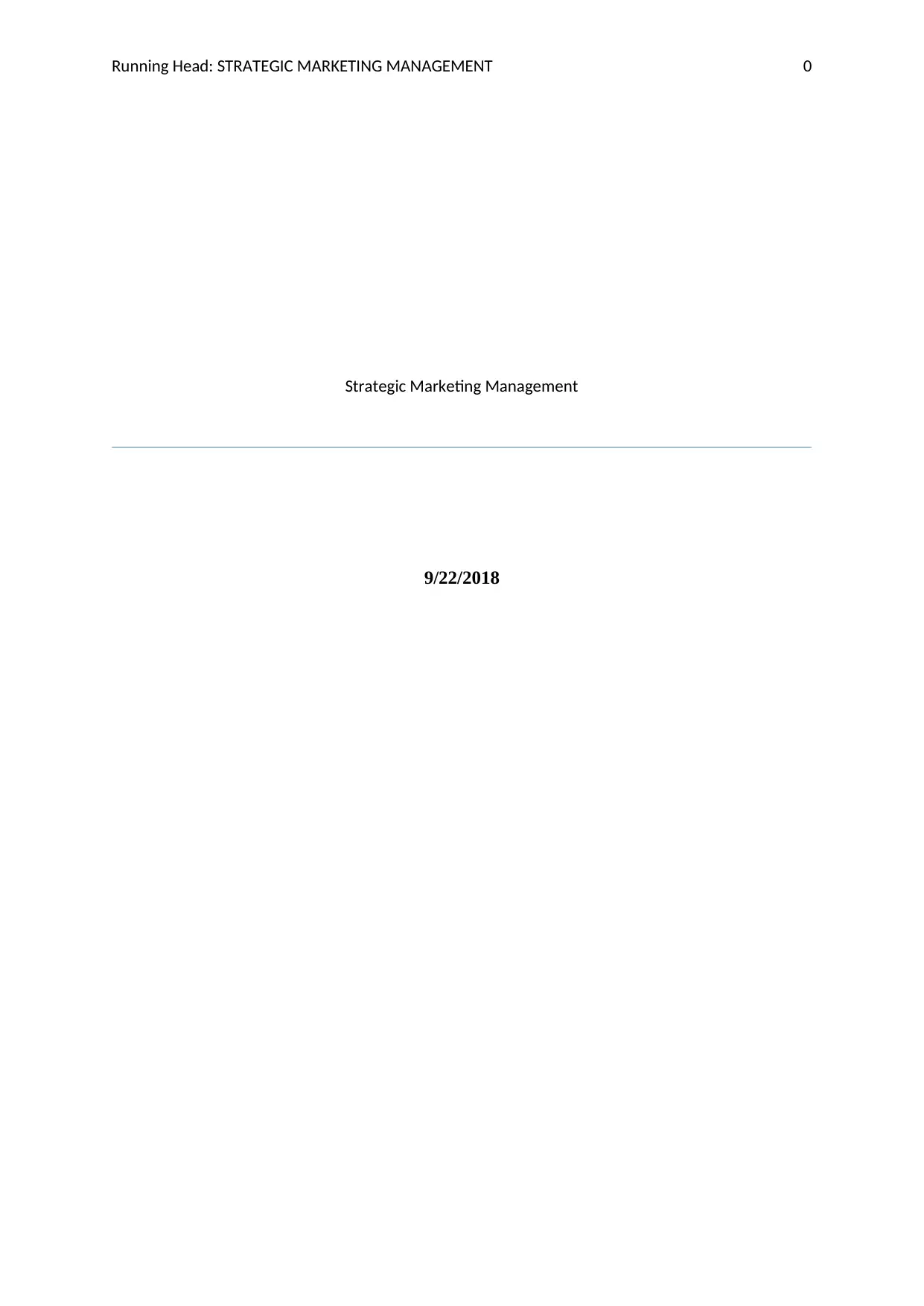
Running Head: STRATEGIC MARKETING MANAGEMENT 0
Strategic Marketing Management
9/22/2018
Strategic Marketing Management
9/22/2018
Paraphrase This Document
Need a fresh take? Get an instant paraphrase of this document with our AI Paraphraser
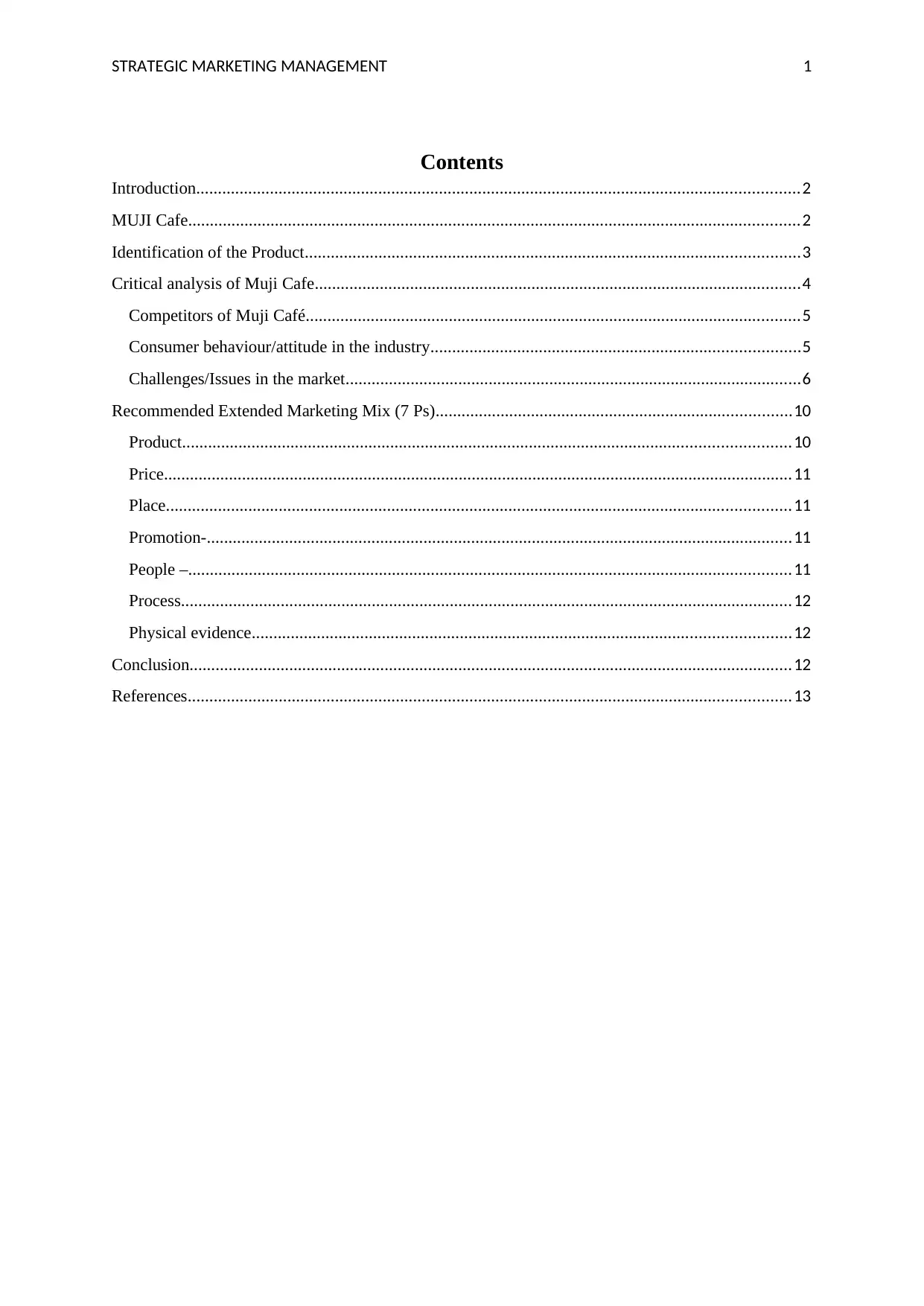
STRATEGIC MARKETING MANAGEMENT 1
Contents
Introduction...........................................................................................................................................2
MUJI Cafe.............................................................................................................................................2
Identification of the Product..................................................................................................................3
Critical analysis of Muji Cafe................................................................................................................4
Competitors of Muji Café..................................................................................................................5
Consumer behaviour/attitude in the industry.....................................................................................5
Challenges/Issues in the market.........................................................................................................6
Recommended Extended Marketing Mix (7 Ps)..................................................................................10
Product............................................................................................................................................10
Price.................................................................................................................................................11
Place................................................................................................................................................11
Promotion-.......................................................................................................................................11
People –...........................................................................................................................................11
Process.............................................................................................................................................12
Physical evidence............................................................................................................................12
Conclusion...........................................................................................................................................12
References...........................................................................................................................................13
Contents
Introduction...........................................................................................................................................2
MUJI Cafe.............................................................................................................................................2
Identification of the Product..................................................................................................................3
Critical analysis of Muji Cafe................................................................................................................4
Competitors of Muji Café..................................................................................................................5
Consumer behaviour/attitude in the industry.....................................................................................5
Challenges/Issues in the market.........................................................................................................6
Recommended Extended Marketing Mix (7 Ps)..................................................................................10
Product............................................................................................................................................10
Price.................................................................................................................................................11
Place................................................................................................................................................11
Promotion-.......................................................................................................................................11
People –...........................................................................................................................................11
Process.............................................................................................................................................12
Physical evidence............................................................................................................................12
Conclusion...........................................................................................................................................12
References...........................................................................................................................................13
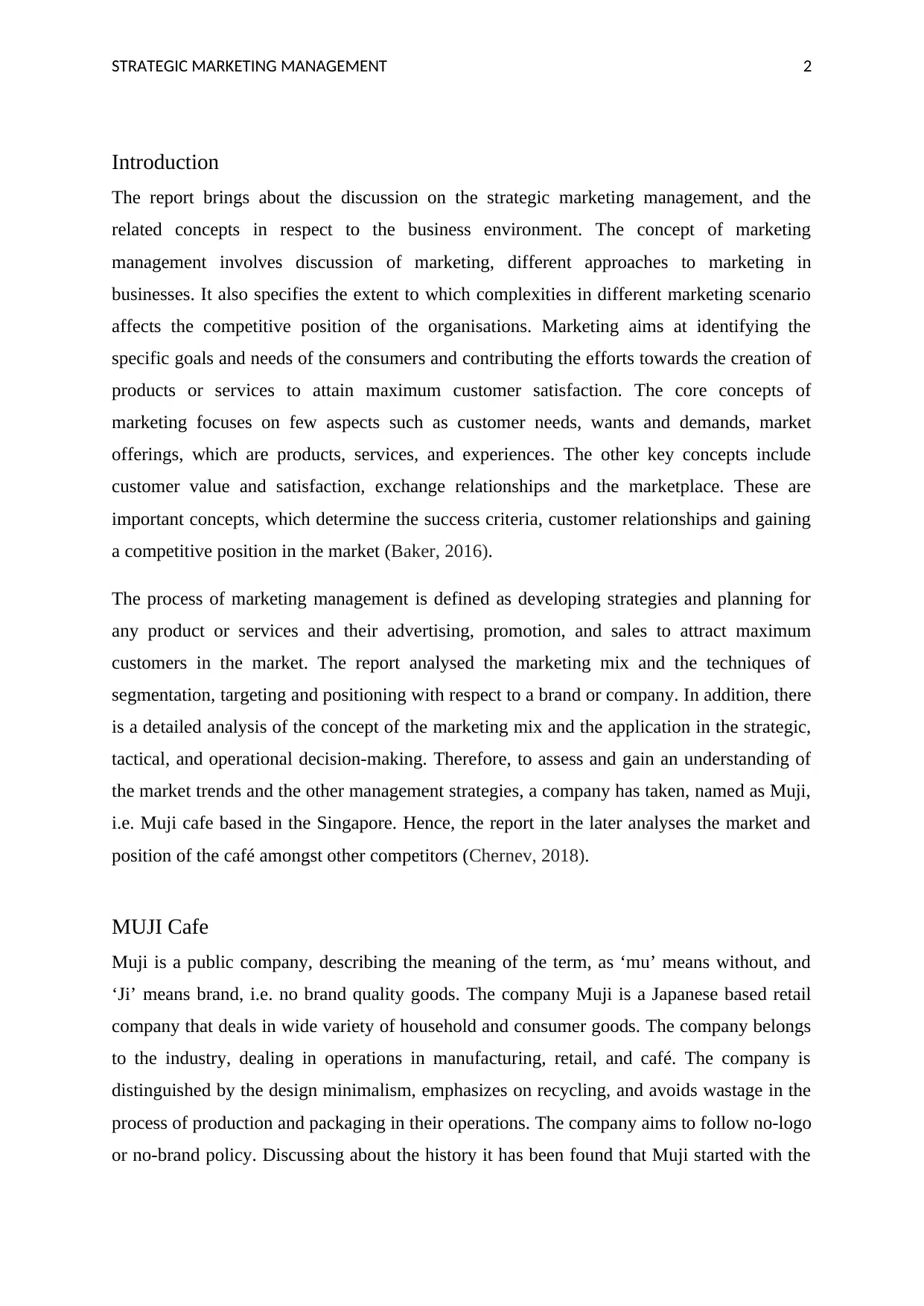
STRATEGIC MARKETING MANAGEMENT 2
Introduction
The report brings about the discussion on the strategic marketing management, and the
related concepts in respect to the business environment. The concept of marketing
management involves discussion of marketing, different approaches to marketing in
businesses. It also specifies the extent to which complexities in different marketing scenario
affects the competitive position of the organisations. Marketing aims at identifying the
specific goals and needs of the consumers and contributing the efforts towards the creation of
products or services to attain maximum customer satisfaction. The core concepts of
marketing focuses on few aspects such as customer needs, wants and demands, market
offerings, which are products, services, and experiences. The other key concepts include
customer value and satisfaction, exchange relationships and the marketplace. These are
important concepts, which determine the success criteria, customer relationships and gaining
a competitive position in the market (Baker, 2016).
The process of marketing management is defined as developing strategies and planning for
any product or services and their advertising, promotion, and sales to attract maximum
customers in the market. The report analysed the marketing mix and the techniques of
segmentation, targeting and positioning with respect to a brand or company. In addition, there
is a detailed analysis of the concept of the marketing mix and the application in the strategic,
tactical, and operational decision-making. Therefore, to assess and gain an understanding of
the market trends and the other management strategies, a company has taken, named as Muji,
i.e. Muji cafe based in the Singapore. Hence, the report in the later analyses the market and
position of the café amongst other competitors (Chernev, 2018).
MUJI Cafe
Muji is a public company, describing the meaning of the term, as ‘mu’ means without, and
‘Ji’ means brand, i.e. no brand quality goods. The company Muji is a Japanese based retail
company that deals in wide variety of household and consumer goods. The company belongs
to the industry, dealing in operations in manufacturing, retail, and café. The company is
distinguished by the design minimalism, emphasizes on recycling, and avoids wastage in the
process of production and packaging in their operations. The company aims to follow no-logo
or no-brand policy. Discussing about the history it has been found that Muji started with the
Introduction
The report brings about the discussion on the strategic marketing management, and the
related concepts in respect to the business environment. The concept of marketing
management involves discussion of marketing, different approaches to marketing in
businesses. It also specifies the extent to which complexities in different marketing scenario
affects the competitive position of the organisations. Marketing aims at identifying the
specific goals and needs of the consumers and contributing the efforts towards the creation of
products or services to attain maximum customer satisfaction. The core concepts of
marketing focuses on few aspects such as customer needs, wants and demands, market
offerings, which are products, services, and experiences. The other key concepts include
customer value and satisfaction, exchange relationships and the marketplace. These are
important concepts, which determine the success criteria, customer relationships and gaining
a competitive position in the market (Baker, 2016).
The process of marketing management is defined as developing strategies and planning for
any product or services and their advertising, promotion, and sales to attract maximum
customers in the market. The report analysed the marketing mix and the techniques of
segmentation, targeting and positioning with respect to a brand or company. In addition, there
is a detailed analysis of the concept of the marketing mix and the application in the strategic,
tactical, and operational decision-making. Therefore, to assess and gain an understanding of
the market trends and the other management strategies, a company has taken, named as Muji,
i.e. Muji cafe based in the Singapore. Hence, the report in the later analyses the market and
position of the café amongst other competitors (Chernev, 2018).
MUJI Cafe
Muji is a public company, describing the meaning of the term, as ‘mu’ means without, and
‘Ji’ means brand, i.e. no brand quality goods. The company Muji is a Japanese based retail
company that deals in wide variety of household and consumer goods. The company belongs
to the industry, dealing in operations in manufacturing, retail, and café. The company is
distinguished by the design minimalism, emphasizes on recycling, and avoids wastage in the
process of production and packaging in their operations. The company aims to follow no-logo
or no-brand policy. Discussing about the history it has been found that Muji started with the
⊘ This is a preview!⊘
Do you want full access?
Subscribe today to unlock all pages.

Trusted by 1+ million students worldwide
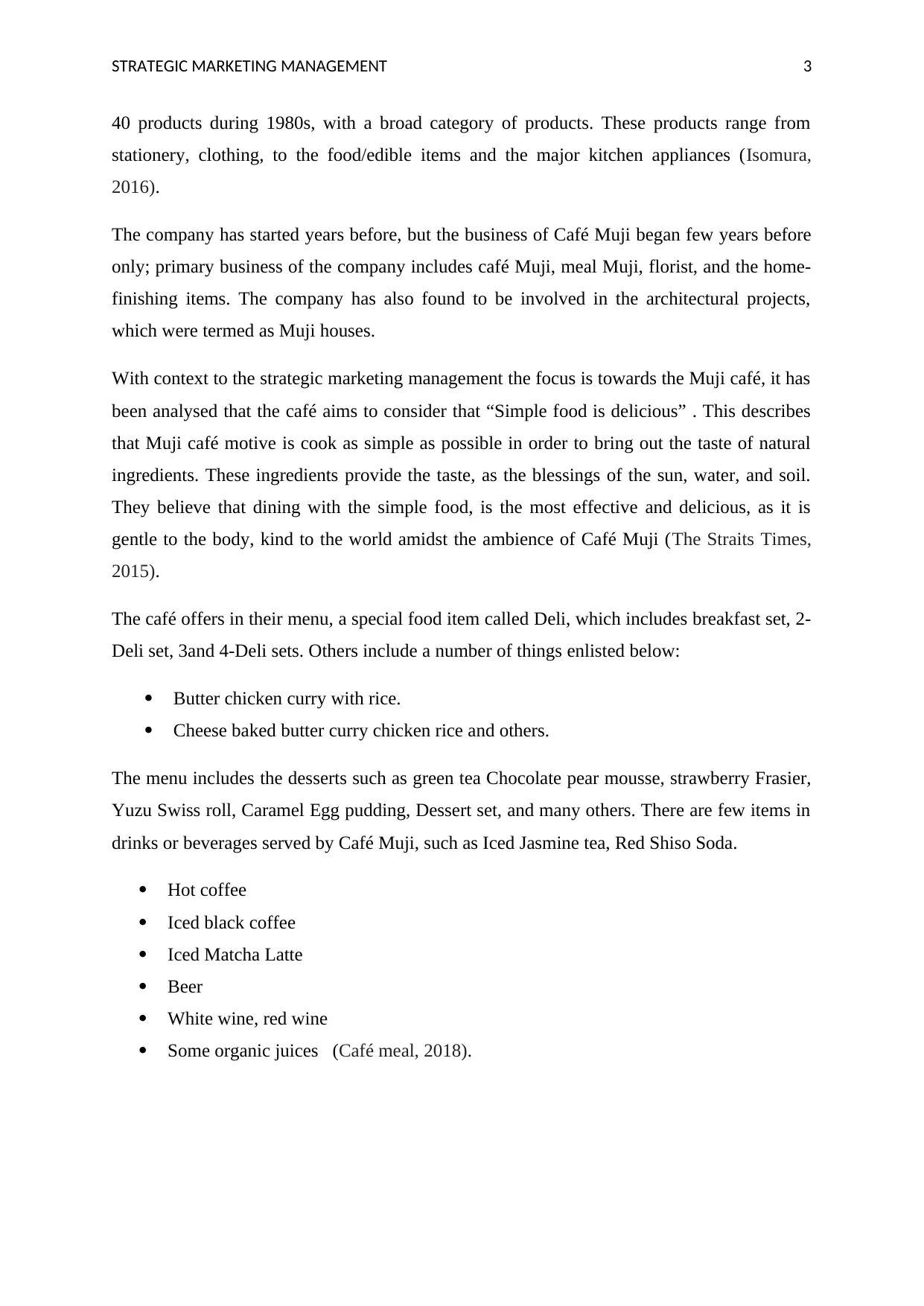
STRATEGIC MARKETING MANAGEMENT 3
40 products during 1980s, with a broad category of products. These products range from
stationery, clothing, to the food/edible items and the major kitchen appliances (Isomura,
2016).
The company has started years before, but the business of Café Muji began few years before
only; primary business of the company includes café Muji, meal Muji, florist, and the home-
finishing items. The company has also found to be involved in the architectural projects,
which were termed as Muji houses.
With context to the strategic marketing management the focus is towards the Muji café, it has
been analysed that the café aims to consider that “Simple food is delicious” . This describes
that Muji café motive is cook as simple as possible in order to bring out the taste of natural
ingredients. These ingredients provide the taste, as the blessings of the sun, water, and soil.
They believe that dining with the simple food, is the most effective and delicious, as it is
gentle to the body, kind to the world amidst the ambience of Café Muji (The Straits Times,
2015).
The café offers in their menu, a special food item called Deli, which includes breakfast set, 2-
Deli set, 3and 4-Deli sets. Others include a number of things enlisted below:
Butter chicken curry with rice.
Cheese baked butter curry chicken rice and others.
The menu includes the desserts such as green tea Chocolate pear mousse, strawberry Frasier,
Yuzu Swiss roll, Caramel Egg pudding, Dessert set, and many others. There are few items in
drinks or beverages served by Café Muji, such as Iced Jasmine tea, Red Shiso Soda.
Hot coffee
Iced black coffee
Iced Matcha Latte
Beer
White wine, red wine
Some organic juices (Café meal, 2018).
40 products during 1980s, with a broad category of products. These products range from
stationery, clothing, to the food/edible items and the major kitchen appliances (Isomura,
2016).
The company has started years before, but the business of Café Muji began few years before
only; primary business of the company includes café Muji, meal Muji, florist, and the home-
finishing items. The company has also found to be involved in the architectural projects,
which were termed as Muji houses.
With context to the strategic marketing management the focus is towards the Muji café, it has
been analysed that the café aims to consider that “Simple food is delicious” . This describes
that Muji café motive is cook as simple as possible in order to bring out the taste of natural
ingredients. These ingredients provide the taste, as the blessings of the sun, water, and soil.
They believe that dining with the simple food, is the most effective and delicious, as it is
gentle to the body, kind to the world amidst the ambience of Café Muji (The Straits Times,
2015).
The café offers in their menu, a special food item called Deli, which includes breakfast set, 2-
Deli set, 3and 4-Deli sets. Others include a number of things enlisted below:
Butter chicken curry with rice.
Cheese baked butter curry chicken rice and others.
The menu includes the desserts such as green tea Chocolate pear mousse, strawberry Frasier,
Yuzu Swiss roll, Caramel Egg pudding, Dessert set, and many others. There are few items in
drinks or beverages served by Café Muji, such as Iced Jasmine tea, Red Shiso Soda.
Hot coffee
Iced black coffee
Iced Matcha Latte
Beer
White wine, red wine
Some organic juices (Café meal, 2018).
Paraphrase This Document
Need a fresh take? Get an instant paraphrase of this document with our AI Paraphraser
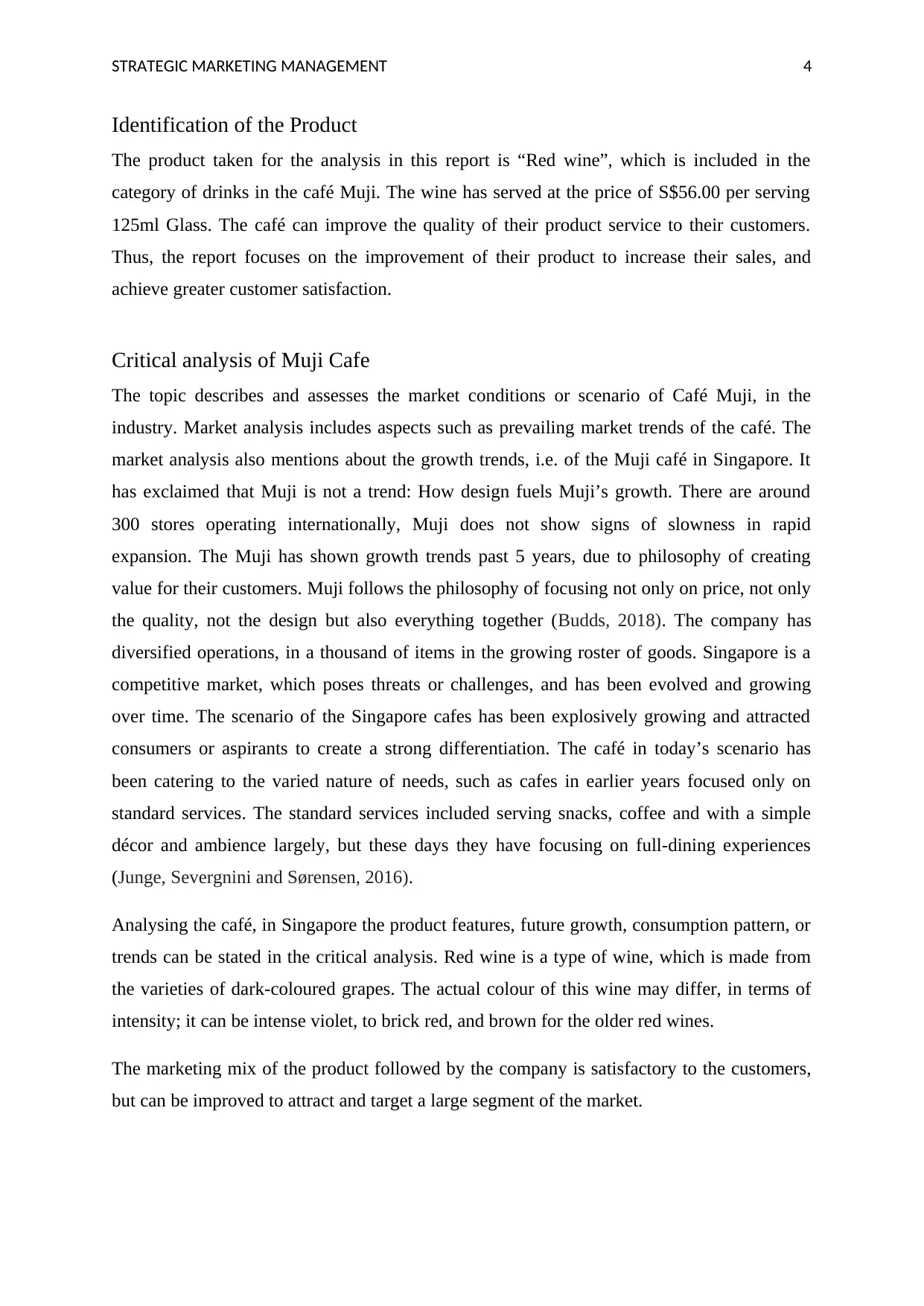
STRATEGIC MARKETING MANAGEMENT 4
Identification of the Product
The product taken for the analysis in this report is “Red wine”, which is included in the
category of drinks in the café Muji. The wine has served at the price of S$56.00 per serving
125ml Glass. The café can improve the quality of their product service to their customers.
Thus, the report focuses on the improvement of their product to increase their sales, and
achieve greater customer satisfaction.
Critical analysis of Muji Cafe
The topic describes and assesses the market conditions or scenario of Café Muji, in the
industry. Market analysis includes aspects such as prevailing market trends of the café. The
market analysis also mentions about the growth trends, i.e. of the Muji café in Singapore. It
has exclaimed that Muji is not a trend: How design fuels Muji’s growth. There are around
300 stores operating internationally, Muji does not show signs of slowness in rapid
expansion. The Muji has shown growth trends past 5 years, due to philosophy of creating
value for their customers. Muji follows the philosophy of focusing not only on price, not only
the quality, not the design but also everything together (Budds, 2018). The company has
diversified operations, in a thousand of items in the growing roster of goods. Singapore is a
competitive market, which poses threats or challenges, and has been evolved and growing
over time. The scenario of the Singapore cafes has been explosively growing and attracted
consumers or aspirants to create a strong differentiation. The café in today’s scenario has
been catering to the varied nature of needs, such as cafes in earlier years focused only on
standard services. The standard services included serving snacks, coffee and with a simple
décor and ambience largely, but these days they have focusing on full-dining experiences
(Junge, Severgnini and Sørensen, 2016).
Analysing the café, in Singapore the product features, future growth, consumption pattern, or
trends can be stated in the critical analysis. Red wine is a type of wine, which is made from
the varieties of dark-coloured grapes. The actual colour of this wine may differ, in terms of
intensity; it can be intense violet, to brick red, and brown for the older red wines.
The marketing mix of the product followed by the company is satisfactory to the customers,
but can be improved to attract and target a large segment of the market.
Identification of the Product
The product taken for the analysis in this report is “Red wine”, which is included in the
category of drinks in the café Muji. The wine has served at the price of S$56.00 per serving
125ml Glass. The café can improve the quality of their product service to their customers.
Thus, the report focuses on the improvement of their product to increase their sales, and
achieve greater customer satisfaction.
Critical analysis of Muji Cafe
The topic describes and assesses the market conditions or scenario of Café Muji, in the
industry. Market analysis includes aspects such as prevailing market trends of the café. The
market analysis also mentions about the growth trends, i.e. of the Muji café in Singapore. It
has exclaimed that Muji is not a trend: How design fuels Muji’s growth. There are around
300 stores operating internationally, Muji does not show signs of slowness in rapid
expansion. The Muji has shown growth trends past 5 years, due to philosophy of creating
value for their customers. Muji follows the philosophy of focusing not only on price, not only
the quality, not the design but also everything together (Budds, 2018). The company has
diversified operations, in a thousand of items in the growing roster of goods. Singapore is a
competitive market, which poses threats or challenges, and has been evolved and growing
over time. The scenario of the Singapore cafes has been explosively growing and attracted
consumers or aspirants to create a strong differentiation. The café in today’s scenario has
been catering to the varied nature of needs, such as cafes in earlier years focused only on
standard services. The standard services included serving snacks, coffee and with a simple
décor and ambience largely, but these days they have focusing on full-dining experiences
(Junge, Severgnini and Sørensen, 2016).
Analysing the café, in Singapore the product features, future growth, consumption pattern, or
trends can be stated in the critical analysis. Red wine is a type of wine, which is made from
the varieties of dark-coloured grapes. The actual colour of this wine may differ, in terms of
intensity; it can be intense violet, to brick red, and brown for the older red wines.
The marketing mix of the product followed by the company is satisfactory to the customers,
but can be improved to attract and target a large segment of the market.
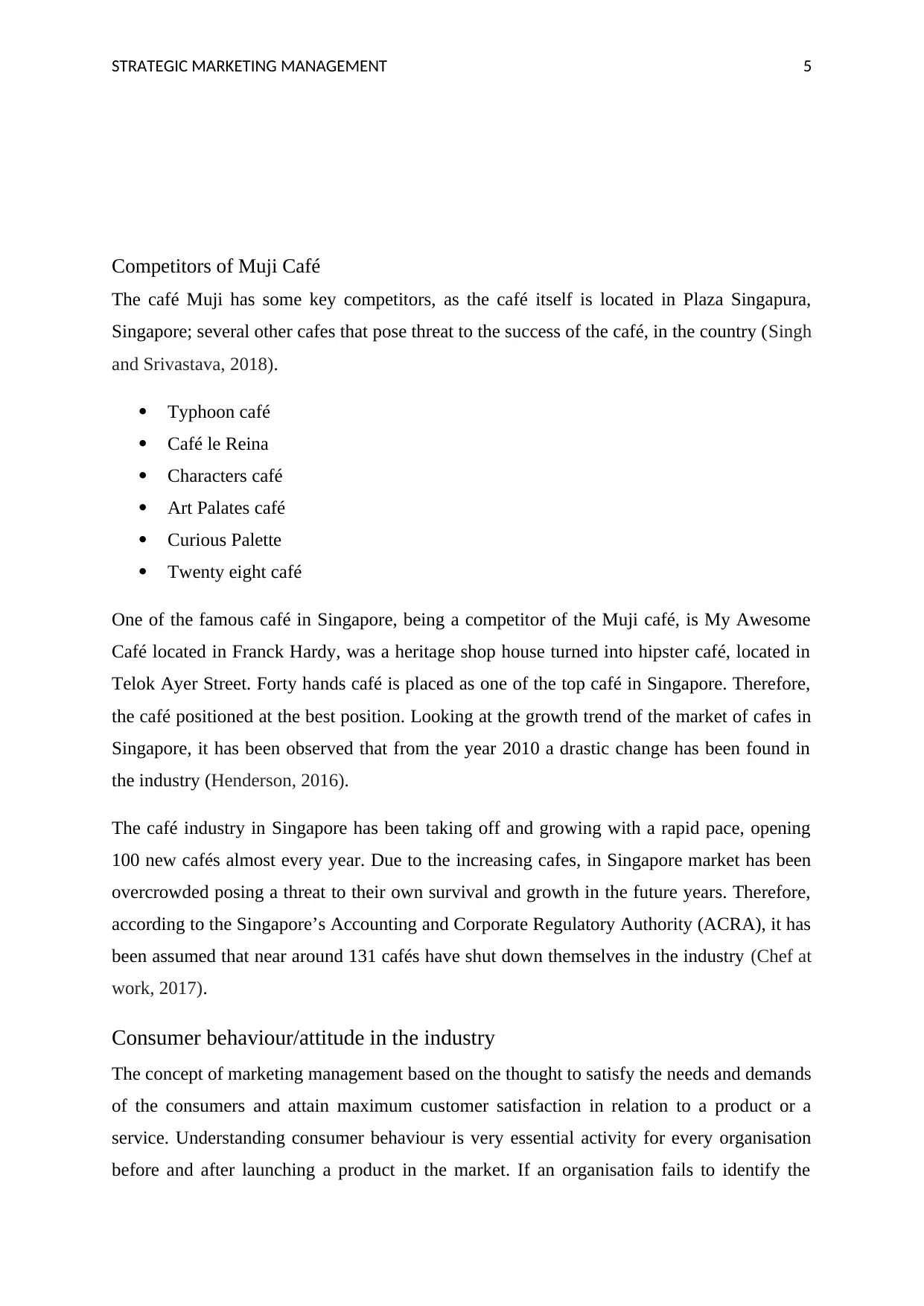
STRATEGIC MARKETING MANAGEMENT 5
Competitors of Muji Café
The café Muji has some key competitors, as the café itself is located in Plaza Singapura,
Singapore; several other cafes that pose threat to the success of the café, in the country (Singh
and Srivastava, 2018).
Typhoon café
Café le Reina
Characters café
Art Palates café
Curious Palette
Twenty eight café
One of the famous café in Singapore, being a competitor of the Muji café, is My Awesome
Café located in Franck Hardy, was a heritage shop house turned into hipster café, located in
Telok Ayer Street. Forty hands café is placed as one of the top café in Singapore. Therefore,
the café positioned at the best position. Looking at the growth trend of the market of cafes in
Singapore, it has been observed that from the year 2010 a drastic change has been found in
the industry (Henderson, 2016).
The café industry in Singapore has been taking off and growing with a rapid pace, opening
100 new cafés almost every year. Due to the increasing cafes, in Singapore market has been
overcrowded posing a threat to their own survival and growth in the future years. Therefore,
according to the Singapore’s Accounting and Corporate Regulatory Authority (ACRA), it has
been assumed that near around 131 cafés have shut down themselves in the industry (Chef at
work, 2017).
Consumer behaviour/attitude in the industry
The concept of marketing management based on the thought to satisfy the needs and demands
of the consumers and attain maximum customer satisfaction in relation to a product or a
service. Understanding consumer behaviour is very essential activity for every organisation
before and after launching a product in the market. If an organisation fails to identify the
Competitors of Muji Café
The café Muji has some key competitors, as the café itself is located in Plaza Singapura,
Singapore; several other cafes that pose threat to the success of the café, in the country (Singh
and Srivastava, 2018).
Typhoon café
Café le Reina
Characters café
Art Palates café
Curious Palette
Twenty eight café
One of the famous café in Singapore, being a competitor of the Muji café, is My Awesome
Café located in Franck Hardy, was a heritage shop house turned into hipster café, located in
Telok Ayer Street. Forty hands café is placed as one of the top café in Singapore. Therefore,
the café positioned at the best position. Looking at the growth trend of the market of cafes in
Singapore, it has been observed that from the year 2010 a drastic change has been found in
the industry (Henderson, 2016).
The café industry in Singapore has been taking off and growing with a rapid pace, opening
100 new cafés almost every year. Due to the increasing cafes, in Singapore market has been
overcrowded posing a threat to their own survival and growth in the future years. Therefore,
according to the Singapore’s Accounting and Corporate Regulatory Authority (ACRA), it has
been assumed that near around 131 cafés have shut down themselves in the industry (Chef at
work, 2017).
Consumer behaviour/attitude in the industry
The concept of marketing management based on the thought to satisfy the needs and demands
of the consumers and attain maximum customer satisfaction in relation to a product or a
service. Understanding consumer behaviour is very essential activity for every organisation
before and after launching a product in the market. If an organisation fails to identify the
⊘ This is a preview!⊘
Do you want full access?
Subscribe today to unlock all pages.

Trusted by 1+ million students worldwide
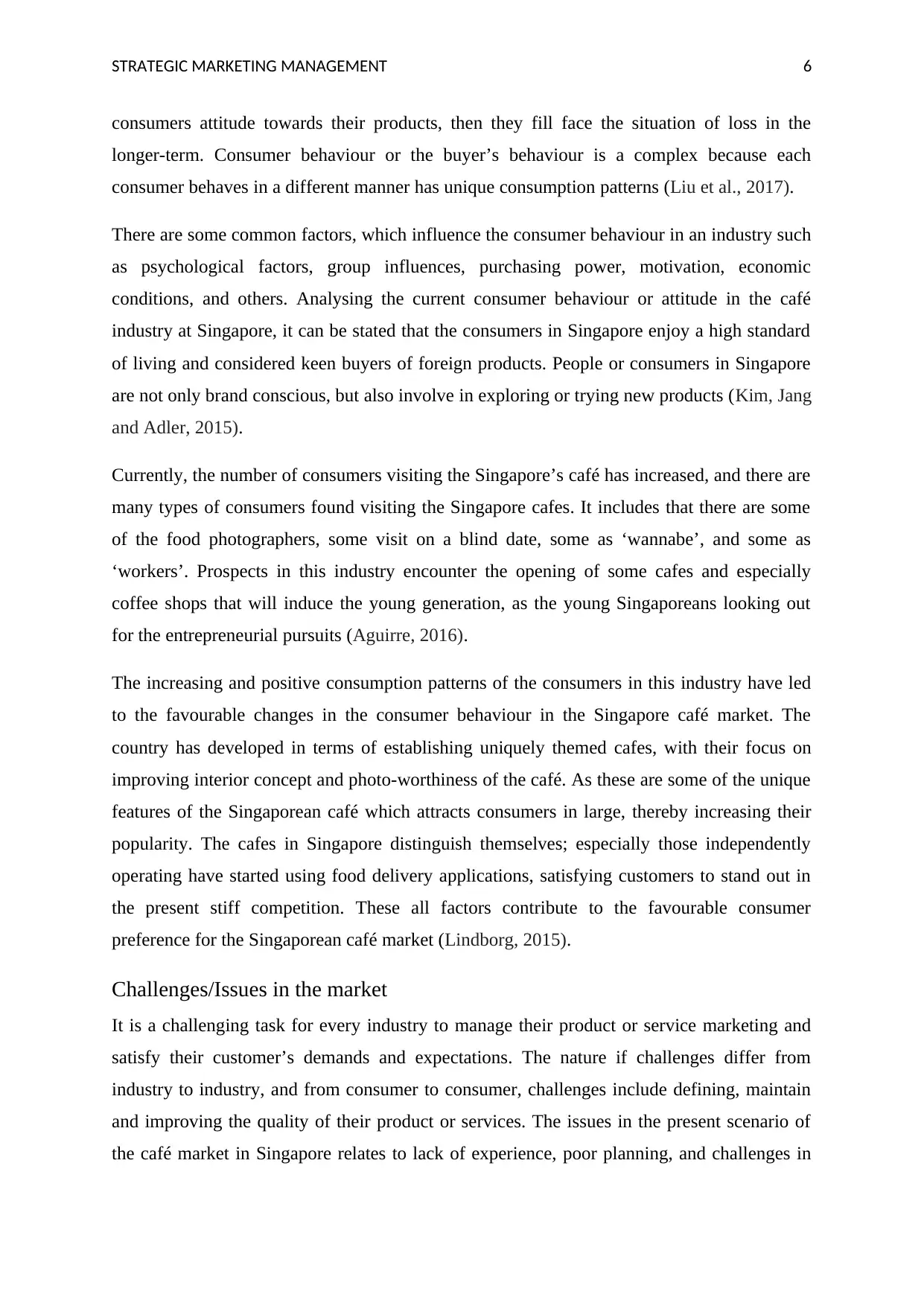
STRATEGIC MARKETING MANAGEMENT 6
consumers attitude towards their products, then they fill face the situation of loss in the
longer-term. Consumer behaviour or the buyer’s behaviour is a complex because each
consumer behaves in a different manner has unique consumption patterns (Liu et al., 2017).
There are some common factors, which influence the consumer behaviour in an industry such
as psychological factors, group influences, purchasing power, motivation, economic
conditions, and others. Analysing the current consumer behaviour or attitude in the café
industry at Singapore, it can be stated that the consumers in Singapore enjoy a high standard
of living and considered keen buyers of foreign products. People or consumers in Singapore
are not only brand conscious, but also involve in exploring or trying new products (Kim, Jang
and Adler, 2015).
Currently, the number of consumers visiting the Singapore’s café has increased, and there are
many types of consumers found visiting the Singapore cafes. It includes that there are some
of the food photographers, some visit on a blind date, some as ‘wannabe’, and some as
‘workers’. Prospects in this industry encounter the opening of some cafes and especially
coffee shops that will induce the young generation, as the young Singaporeans looking out
for the entrepreneurial pursuits (Aguirre, 2016).
The increasing and positive consumption patterns of the consumers in this industry have led
to the favourable changes in the consumer behaviour in the Singapore café market. The
country has developed in terms of establishing uniquely themed cafes, with their focus on
improving interior concept and photo-worthiness of the café. As these are some of the unique
features of the Singaporean café which attracts consumers in large, thereby increasing their
popularity. The cafes in Singapore distinguish themselves; especially those independently
operating have started using food delivery applications, satisfying customers to stand out in
the present stiff competition. These all factors contribute to the favourable consumer
preference for the Singaporean café market (Lindborg, 2015).
Challenges/Issues in the market
It is a challenging task for every industry to manage their product or service marketing and
satisfy their customer’s demands and expectations. The nature if challenges differ from
industry to industry, and from consumer to consumer, challenges include defining, maintain
and improving the quality of their product or services. The issues in the present scenario of
the café market in Singapore relates to lack of experience, poor planning, and challenges in
consumers attitude towards their products, then they fill face the situation of loss in the
longer-term. Consumer behaviour or the buyer’s behaviour is a complex because each
consumer behaves in a different manner has unique consumption patterns (Liu et al., 2017).
There are some common factors, which influence the consumer behaviour in an industry such
as psychological factors, group influences, purchasing power, motivation, economic
conditions, and others. Analysing the current consumer behaviour or attitude in the café
industry at Singapore, it can be stated that the consumers in Singapore enjoy a high standard
of living and considered keen buyers of foreign products. People or consumers in Singapore
are not only brand conscious, but also involve in exploring or trying new products (Kim, Jang
and Adler, 2015).
Currently, the number of consumers visiting the Singapore’s café has increased, and there are
many types of consumers found visiting the Singapore cafes. It includes that there are some
of the food photographers, some visit on a blind date, some as ‘wannabe’, and some as
‘workers’. Prospects in this industry encounter the opening of some cafes and especially
coffee shops that will induce the young generation, as the young Singaporeans looking out
for the entrepreneurial pursuits (Aguirre, 2016).
The increasing and positive consumption patterns of the consumers in this industry have led
to the favourable changes in the consumer behaviour in the Singapore café market. The
country has developed in terms of establishing uniquely themed cafes, with their focus on
improving interior concept and photo-worthiness of the café. As these are some of the unique
features of the Singaporean café which attracts consumers in large, thereby increasing their
popularity. The cafes in Singapore distinguish themselves; especially those independently
operating have started using food delivery applications, satisfying customers to stand out in
the present stiff competition. These all factors contribute to the favourable consumer
preference for the Singaporean café market (Lindborg, 2015).
Challenges/Issues in the market
It is a challenging task for every industry to manage their product or service marketing and
satisfy their customer’s demands and expectations. The nature if challenges differ from
industry to industry, and from consumer to consumer, challenges include defining, maintain
and improving the quality of their product or services. The issues in the present scenario of
the café market in Singapore relates to lack of experience, poor planning, and challenges in
Paraphrase This Document
Need a fresh take? Get an instant paraphrase of this document with our AI Paraphraser
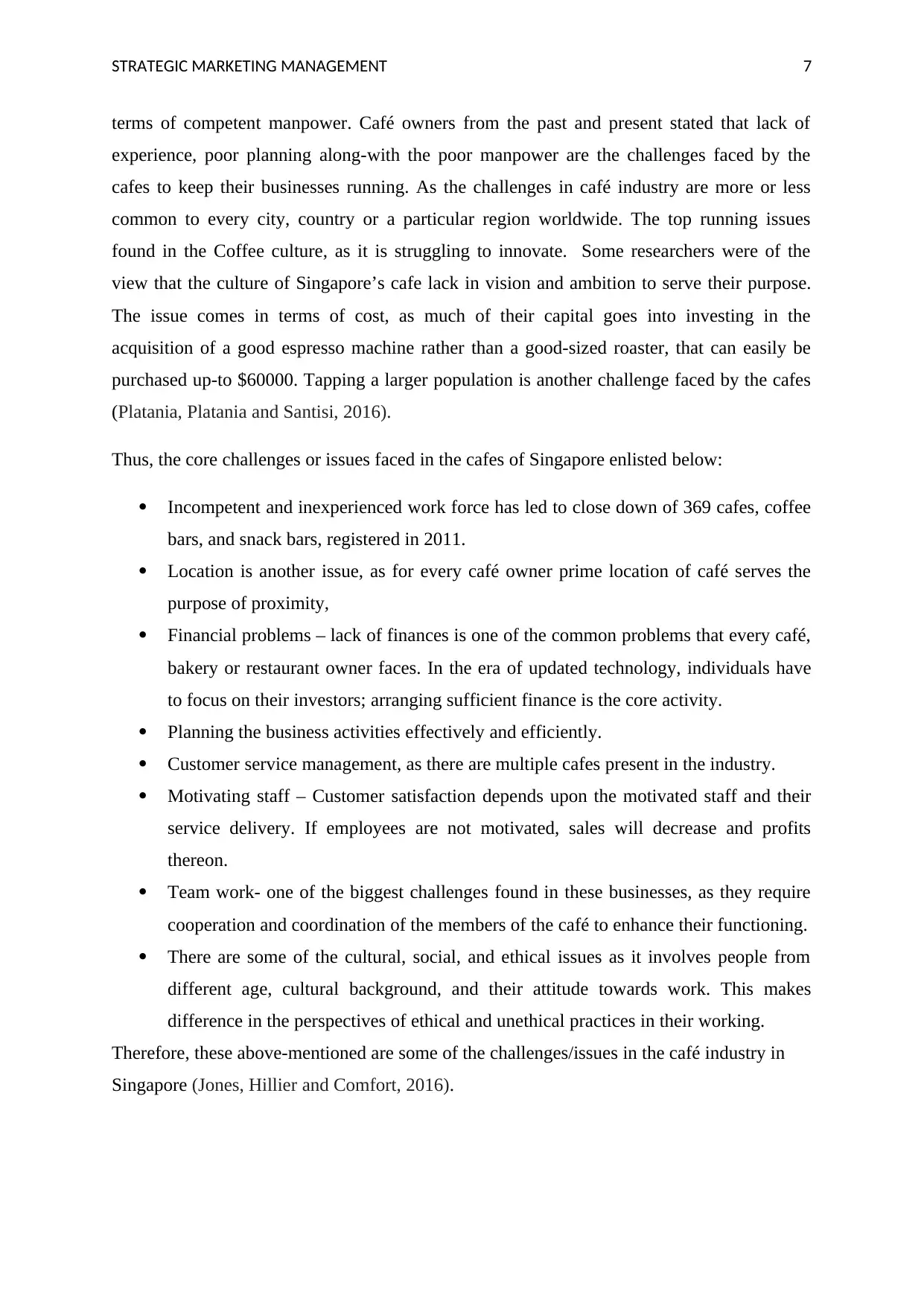
STRATEGIC MARKETING MANAGEMENT 7
terms of competent manpower. Café owners from the past and present stated that lack of
experience, poor planning along-with the poor manpower are the challenges faced by the
cafes to keep their businesses running. As the challenges in café industry are more or less
common to every city, country or a particular region worldwide. The top running issues
found in the Coffee culture, as it is struggling to innovate. Some researchers were of the
view that the culture of Singapore’s cafe lack in vision and ambition to serve their purpose.
The issue comes in terms of cost, as much of their capital goes into investing in the
acquisition of a good espresso machine rather than a good-sized roaster, that can easily be
purchased up-to $60000. Tapping a larger population is another challenge faced by the cafes
(Platania, Platania and Santisi, 2016).
Thus, the core challenges or issues faced in the cafes of Singapore enlisted below:
Incompetent and inexperienced work force has led to close down of 369 cafes, coffee
bars, and snack bars, registered in 2011.
Location is another issue, as for every café owner prime location of café serves the
purpose of proximity,
Financial problems – lack of finances is one of the common problems that every café,
bakery or restaurant owner faces. In the era of updated technology, individuals have
to focus on their investors; arranging sufficient finance is the core activity.
Planning the business activities effectively and efficiently.
Customer service management, as there are multiple cafes present in the industry.
Motivating staff – Customer satisfaction depends upon the motivated staff and their
service delivery. If employees are not motivated, sales will decrease and profits
thereon.
Team work- one of the biggest challenges found in these businesses, as they require
cooperation and coordination of the members of the café to enhance their functioning.
There are some of the cultural, social, and ethical issues as it involves people from
different age, cultural background, and their attitude towards work. This makes
difference in the perspectives of ethical and unethical practices in their working.
Therefore, these above-mentioned are some of the challenges/issues in the café industry in
Singapore (Jones, Hillier and Comfort, 2016).
terms of competent manpower. Café owners from the past and present stated that lack of
experience, poor planning along-with the poor manpower are the challenges faced by the
cafes to keep their businesses running. As the challenges in café industry are more or less
common to every city, country or a particular region worldwide. The top running issues
found in the Coffee culture, as it is struggling to innovate. Some researchers were of the
view that the culture of Singapore’s cafe lack in vision and ambition to serve their purpose.
The issue comes in terms of cost, as much of their capital goes into investing in the
acquisition of a good espresso machine rather than a good-sized roaster, that can easily be
purchased up-to $60000. Tapping a larger population is another challenge faced by the cafes
(Platania, Platania and Santisi, 2016).
Thus, the core challenges or issues faced in the cafes of Singapore enlisted below:
Incompetent and inexperienced work force has led to close down of 369 cafes, coffee
bars, and snack bars, registered in 2011.
Location is another issue, as for every café owner prime location of café serves the
purpose of proximity,
Financial problems – lack of finances is one of the common problems that every café,
bakery or restaurant owner faces. In the era of updated technology, individuals have
to focus on their investors; arranging sufficient finance is the core activity.
Planning the business activities effectively and efficiently.
Customer service management, as there are multiple cafes present in the industry.
Motivating staff – Customer satisfaction depends upon the motivated staff and their
service delivery. If employees are not motivated, sales will decrease and profits
thereon.
Team work- one of the biggest challenges found in these businesses, as they require
cooperation and coordination of the members of the café to enhance their functioning.
There are some of the cultural, social, and ethical issues as it involves people from
different age, cultural background, and their attitude towards work. This makes
difference in the perspectives of ethical and unethical practices in their working.
Therefore, these above-mentioned are some of the challenges/issues in the café industry in
Singapore (Jones, Hillier and Comfort, 2016).
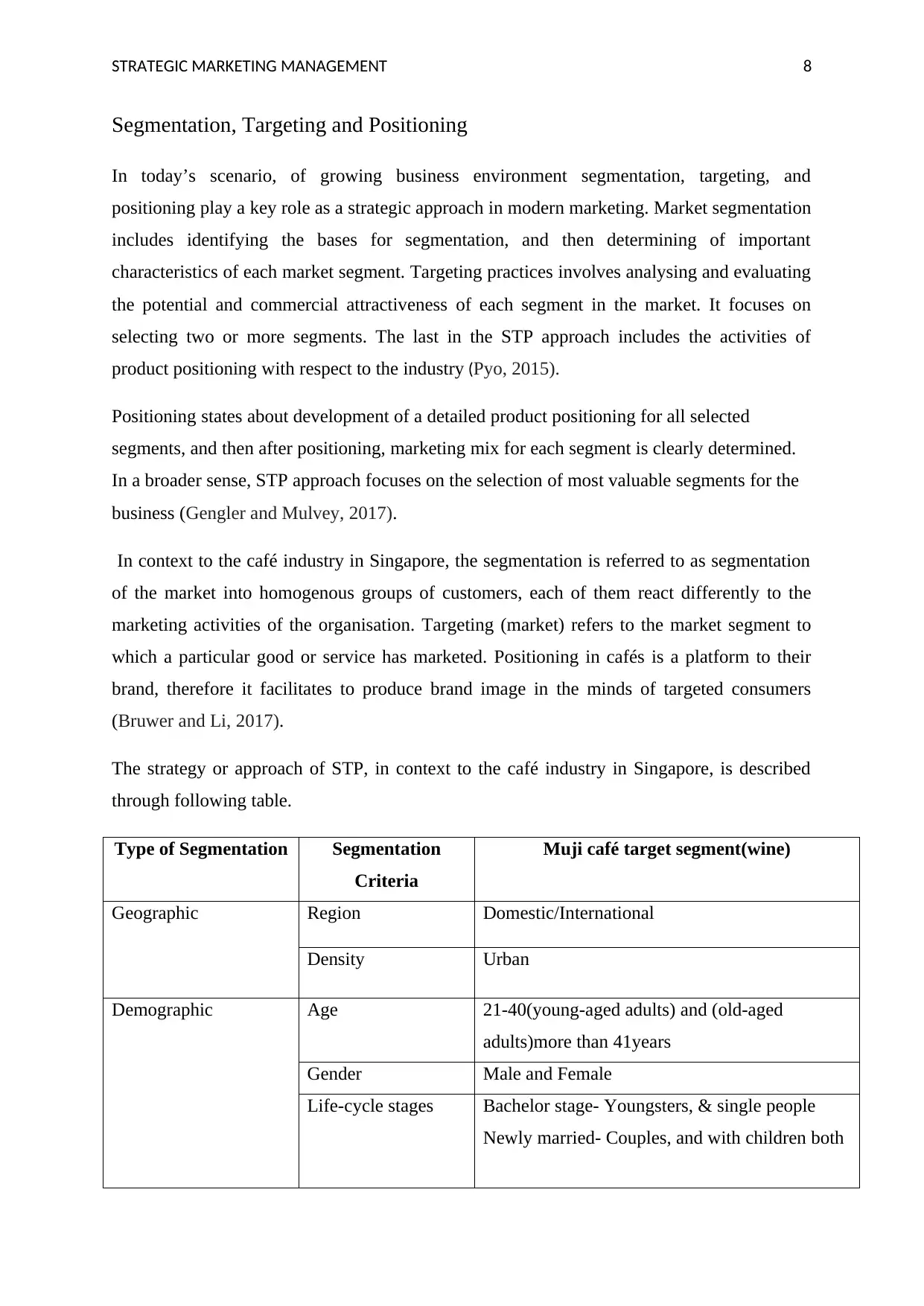
STRATEGIC MARKETING MANAGEMENT 8
Segmentation, Targeting and Positioning
In today’s scenario, of growing business environment segmentation, targeting, and
positioning play a key role as a strategic approach in modern marketing. Market segmentation
includes identifying the bases for segmentation, and then determining of important
characteristics of each market segment. Targeting practices involves analysing and evaluating
the potential and commercial attractiveness of each segment in the market. It focuses on
selecting two or more segments. The last in the STP approach includes the activities of
product positioning with respect to the industry (Pyo, 2015).
Positioning states about development of a detailed product positioning for all selected
segments, and then after positioning, marketing mix for each segment is clearly determined.
In a broader sense, STP approach focuses on the selection of most valuable segments for the
business (Gengler and Mulvey, 2017).
In context to the café industry in Singapore, the segmentation is referred to as segmentation
of the market into homogenous groups of customers, each of them react differently to the
marketing activities of the organisation. Targeting (market) refers to the market segment to
which a particular good or service has marketed. Positioning in cafés is a platform to their
brand, therefore it facilitates to produce brand image in the minds of targeted consumers
(Bruwer and Li, 2017).
The strategy or approach of STP, in context to the café industry in Singapore, is described
through following table.
Type of Segmentation Segmentation
Criteria
Muji café target segment(wine)
Geographic Region Domestic/International
Density Urban
Demographic Age 21-40(young-aged adults) and (old-aged
adults)more than 41years
Gender Male and Female
Life-cycle stages Bachelor stage- Youngsters, & single people
Newly married- Couples, and with children both
Segmentation, Targeting and Positioning
In today’s scenario, of growing business environment segmentation, targeting, and
positioning play a key role as a strategic approach in modern marketing. Market segmentation
includes identifying the bases for segmentation, and then determining of important
characteristics of each market segment. Targeting practices involves analysing and evaluating
the potential and commercial attractiveness of each segment in the market. It focuses on
selecting two or more segments. The last in the STP approach includes the activities of
product positioning with respect to the industry (Pyo, 2015).
Positioning states about development of a detailed product positioning for all selected
segments, and then after positioning, marketing mix for each segment is clearly determined.
In a broader sense, STP approach focuses on the selection of most valuable segments for the
business (Gengler and Mulvey, 2017).
In context to the café industry in Singapore, the segmentation is referred to as segmentation
of the market into homogenous groups of customers, each of them react differently to the
marketing activities of the organisation. Targeting (market) refers to the market segment to
which a particular good or service has marketed. Positioning in cafés is a platform to their
brand, therefore it facilitates to produce brand image in the minds of targeted consumers
(Bruwer and Li, 2017).
The strategy or approach of STP, in context to the café industry in Singapore, is described
through following table.
Type of Segmentation Segmentation
Criteria
Muji café target segment(wine)
Geographic Region Domestic/International
Density Urban
Demographic Age 21-40(young-aged adults) and (old-aged
adults)more than 41years
Gender Male and Female
Life-cycle stages Bachelor stage- Youngsters, & single people
Newly married- Couples, and with children both
⊘ This is a preview!⊘
Do you want full access?
Subscribe today to unlock all pages.

Trusted by 1+ million students worldwide
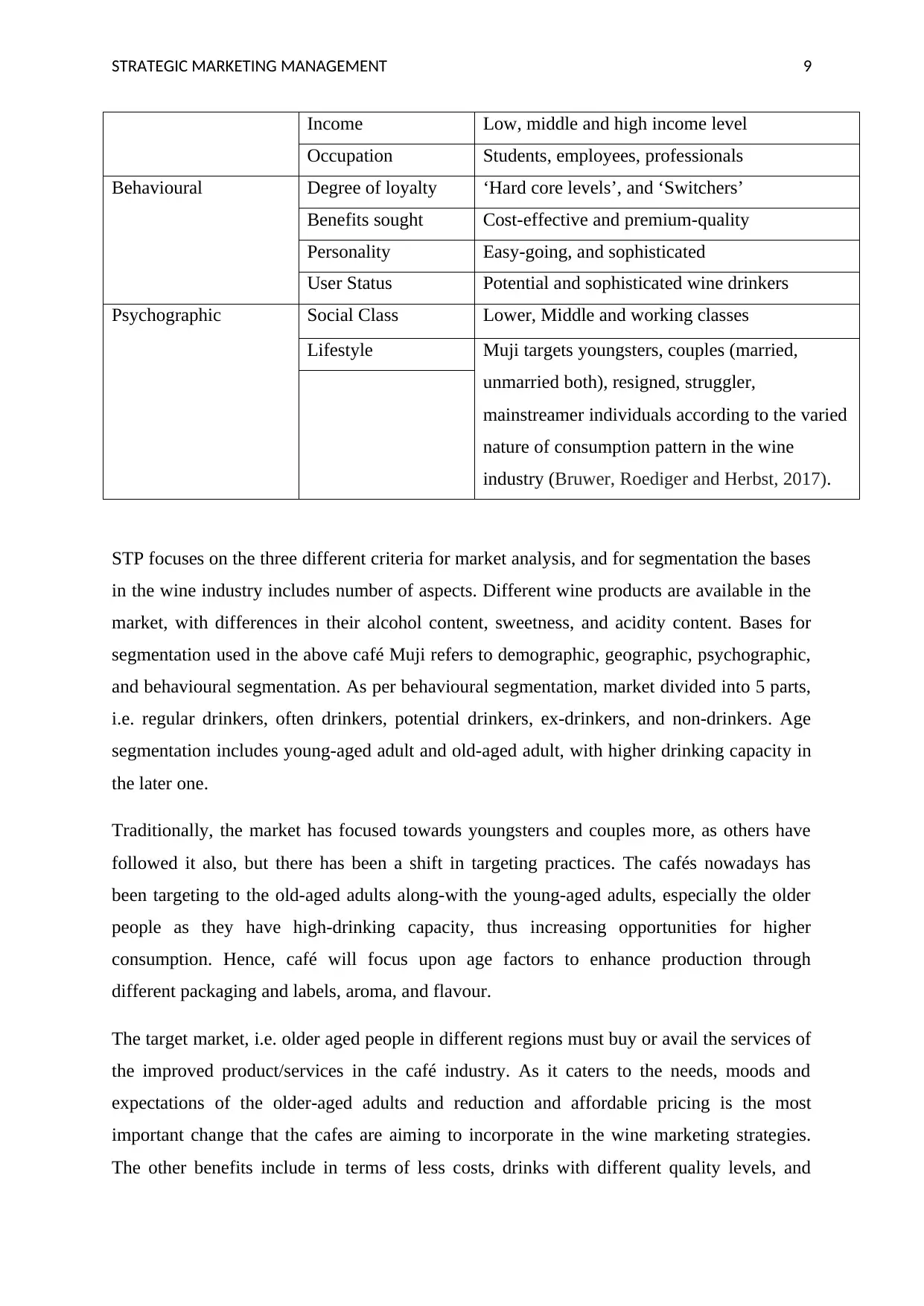
STRATEGIC MARKETING MANAGEMENT 9
Income Low, middle and high income level
Occupation Students, employees, professionals
Behavioural Degree of loyalty ‘Hard core levels’, and ‘Switchers’
Benefits sought Cost-effective and premium-quality
Personality Easy-going, and sophisticated
User Status Potential and sophisticated wine drinkers
Psychographic Social Class Lower, Middle and working classes
Lifestyle Muji targets youngsters, couples (married,
unmarried both), resigned, struggler,
mainstreamer individuals according to the varied
nature of consumption pattern in the wine
industry (Bruwer, Roediger and Herbst, 2017).
STP focuses on the three different criteria for market analysis, and for segmentation the bases
in the wine industry includes number of aspects. Different wine products are available in the
market, with differences in their alcohol content, sweetness, and acidity content. Bases for
segmentation used in the above café Muji refers to demographic, geographic, psychographic,
and behavioural segmentation. As per behavioural segmentation, market divided into 5 parts,
i.e. regular drinkers, often drinkers, potential drinkers, ex-drinkers, and non-drinkers. Age
segmentation includes young-aged adult and old-aged adult, with higher drinking capacity in
the later one.
Traditionally, the market has focused towards youngsters and couples more, as others have
followed it also, but there has been a shift in targeting practices. The cafés nowadays has
been targeting to the old-aged adults along-with the young-aged adults, especially the older
people as they have high-drinking capacity, thus increasing opportunities for higher
consumption. Hence, café will focus upon age factors to enhance production through
different packaging and labels, aroma, and flavour.
The target market, i.e. older aged people in different regions must buy or avail the services of
the improved product/services in the café industry. As it caters to the needs, moods and
expectations of the older-aged adults and reduction and affordable pricing is the most
important change that the cafes are aiming to incorporate in the wine marketing strategies.
The other benefits include in terms of less costs, drinks with different quality levels, and
Income Low, middle and high income level
Occupation Students, employees, professionals
Behavioural Degree of loyalty ‘Hard core levels’, and ‘Switchers’
Benefits sought Cost-effective and premium-quality
Personality Easy-going, and sophisticated
User Status Potential and sophisticated wine drinkers
Psychographic Social Class Lower, Middle and working classes
Lifestyle Muji targets youngsters, couples (married,
unmarried both), resigned, struggler,
mainstreamer individuals according to the varied
nature of consumption pattern in the wine
industry (Bruwer, Roediger and Herbst, 2017).
STP focuses on the three different criteria for market analysis, and for segmentation the bases
in the wine industry includes number of aspects. Different wine products are available in the
market, with differences in their alcohol content, sweetness, and acidity content. Bases for
segmentation used in the above café Muji refers to demographic, geographic, psychographic,
and behavioural segmentation. As per behavioural segmentation, market divided into 5 parts,
i.e. regular drinkers, often drinkers, potential drinkers, ex-drinkers, and non-drinkers. Age
segmentation includes young-aged adult and old-aged adult, with higher drinking capacity in
the later one.
Traditionally, the market has focused towards youngsters and couples more, as others have
followed it also, but there has been a shift in targeting practices. The cafés nowadays has
been targeting to the old-aged adults along-with the young-aged adults, especially the older
people as they have high-drinking capacity, thus increasing opportunities for higher
consumption. Hence, café will focus upon age factors to enhance production through
different packaging and labels, aroma, and flavour.
The target market, i.e. older aged people in different regions must buy or avail the services of
the improved product/services in the café industry. As it caters to the needs, moods and
expectations of the older-aged adults and reduction and affordable pricing is the most
important change that the cafes are aiming to incorporate in the wine marketing strategies.
The other benefits include in terms of less costs, drinks with different quality levels, and
Paraphrase This Document
Need a fresh take? Get an instant paraphrase of this document with our AI Paraphraser
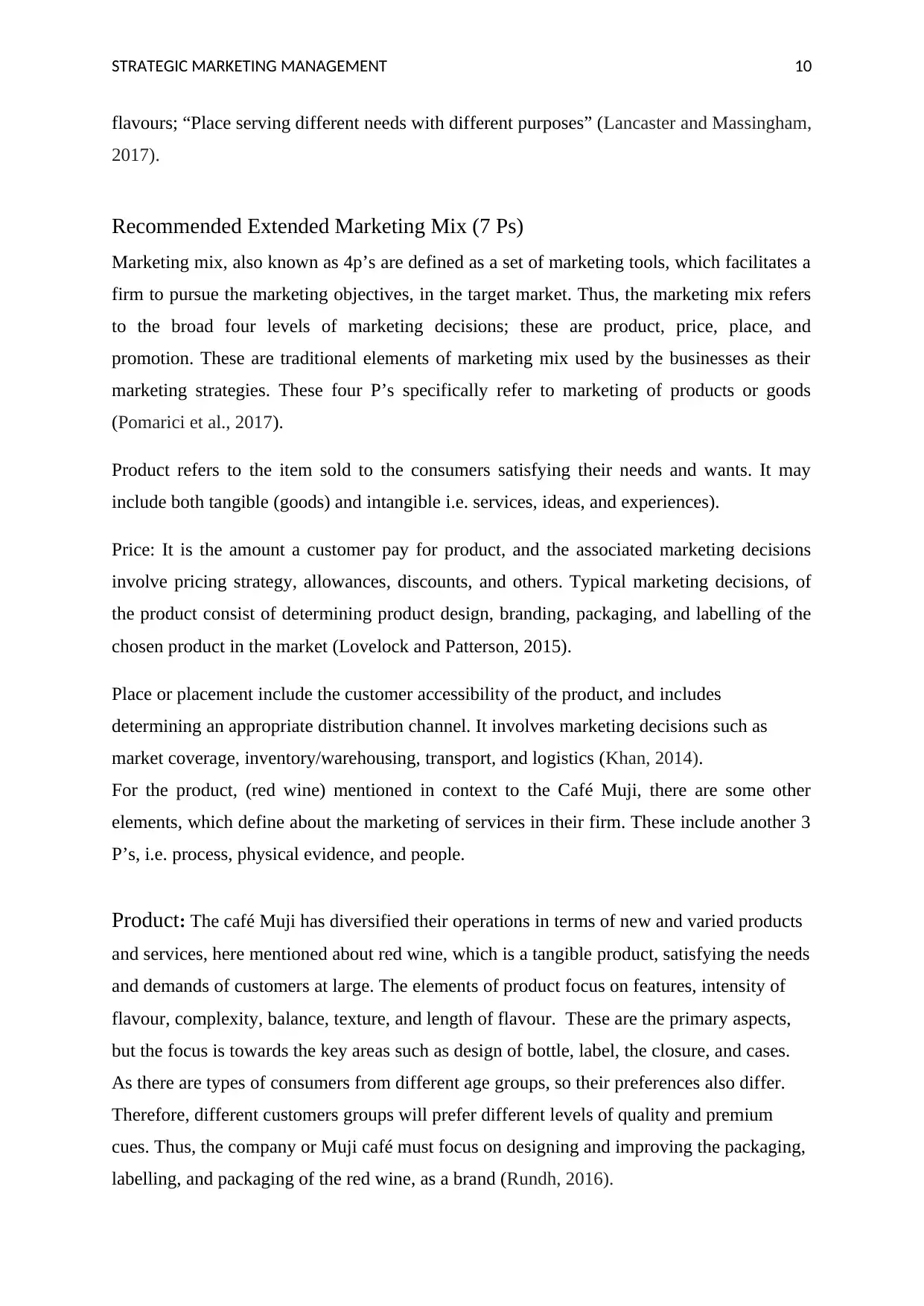
STRATEGIC MARKETING MANAGEMENT 10
flavours; “Place serving different needs with different purposes” (Lancaster and Massingham,
2017).
Recommended Extended Marketing Mix (7 Ps)
Marketing mix, also known as 4p’s are defined as a set of marketing tools, which facilitates a
firm to pursue the marketing objectives, in the target market. Thus, the marketing mix refers
to the broad four levels of marketing decisions; these are product, price, place, and
promotion. These are traditional elements of marketing mix used by the businesses as their
marketing strategies. These four P’s specifically refer to marketing of products or goods
(Pomarici et al., 2017).
Product refers to the item sold to the consumers satisfying their needs and wants. It may
include both tangible (goods) and intangible i.e. services, ideas, and experiences).
Price: It is the amount a customer pay for product, and the associated marketing decisions
involve pricing strategy, allowances, discounts, and others. Typical marketing decisions, of
the product consist of determining product design, branding, packaging, and labelling of the
chosen product in the market (Lovelock and Patterson, 2015).
Place or placement include the customer accessibility of the product, and includes
determining an appropriate distribution channel. It involves marketing decisions such as
market coverage, inventory/warehousing, transport, and logistics (Khan, 2014).
For the product, (red wine) mentioned in context to the Café Muji, there are some other
elements, which define about the marketing of services in their firm. These include another 3
P’s, i.e. process, physical evidence, and people.
Product: The café Muji has diversified their operations in terms of new and varied products
and services, here mentioned about red wine, which is a tangible product, satisfying the needs
and demands of customers at large. The elements of product focus on features, intensity of
flavour, complexity, balance, texture, and length of flavour. These are the primary aspects,
but the focus is towards the key areas such as design of bottle, label, the closure, and cases.
As there are types of consumers from different age groups, so their preferences also differ.
Therefore, different customers groups will prefer different levels of quality and premium
cues. Thus, the company or Muji café must focus on designing and improving the packaging,
labelling, and packaging of the red wine, as a brand (Rundh, 2016).
flavours; “Place serving different needs with different purposes” (Lancaster and Massingham,
2017).
Recommended Extended Marketing Mix (7 Ps)
Marketing mix, also known as 4p’s are defined as a set of marketing tools, which facilitates a
firm to pursue the marketing objectives, in the target market. Thus, the marketing mix refers
to the broad four levels of marketing decisions; these are product, price, place, and
promotion. These are traditional elements of marketing mix used by the businesses as their
marketing strategies. These four P’s specifically refer to marketing of products or goods
(Pomarici et al., 2017).
Product refers to the item sold to the consumers satisfying their needs and wants. It may
include both tangible (goods) and intangible i.e. services, ideas, and experiences).
Price: It is the amount a customer pay for product, and the associated marketing decisions
involve pricing strategy, allowances, discounts, and others. Typical marketing decisions, of
the product consist of determining product design, branding, packaging, and labelling of the
chosen product in the market (Lovelock and Patterson, 2015).
Place or placement include the customer accessibility of the product, and includes
determining an appropriate distribution channel. It involves marketing decisions such as
market coverage, inventory/warehousing, transport, and logistics (Khan, 2014).
For the product, (red wine) mentioned in context to the Café Muji, there are some other
elements, which define about the marketing of services in their firm. These include another 3
P’s, i.e. process, physical evidence, and people.
Product: The café Muji has diversified their operations in terms of new and varied products
and services, here mentioned about red wine, which is a tangible product, satisfying the needs
and demands of customers at large. The elements of product focus on features, intensity of
flavour, complexity, balance, texture, and length of flavour. These are the primary aspects,
but the focus is towards the key areas such as design of bottle, label, the closure, and cases.
As there are types of consumers from different age groups, so their preferences also differ.
Therefore, different customers groups will prefer different levels of quality and premium
cues. Thus, the company or Muji café must focus on designing and improving the packaging,
labelling, and packaging of the red wine, as a brand (Rundh, 2016).
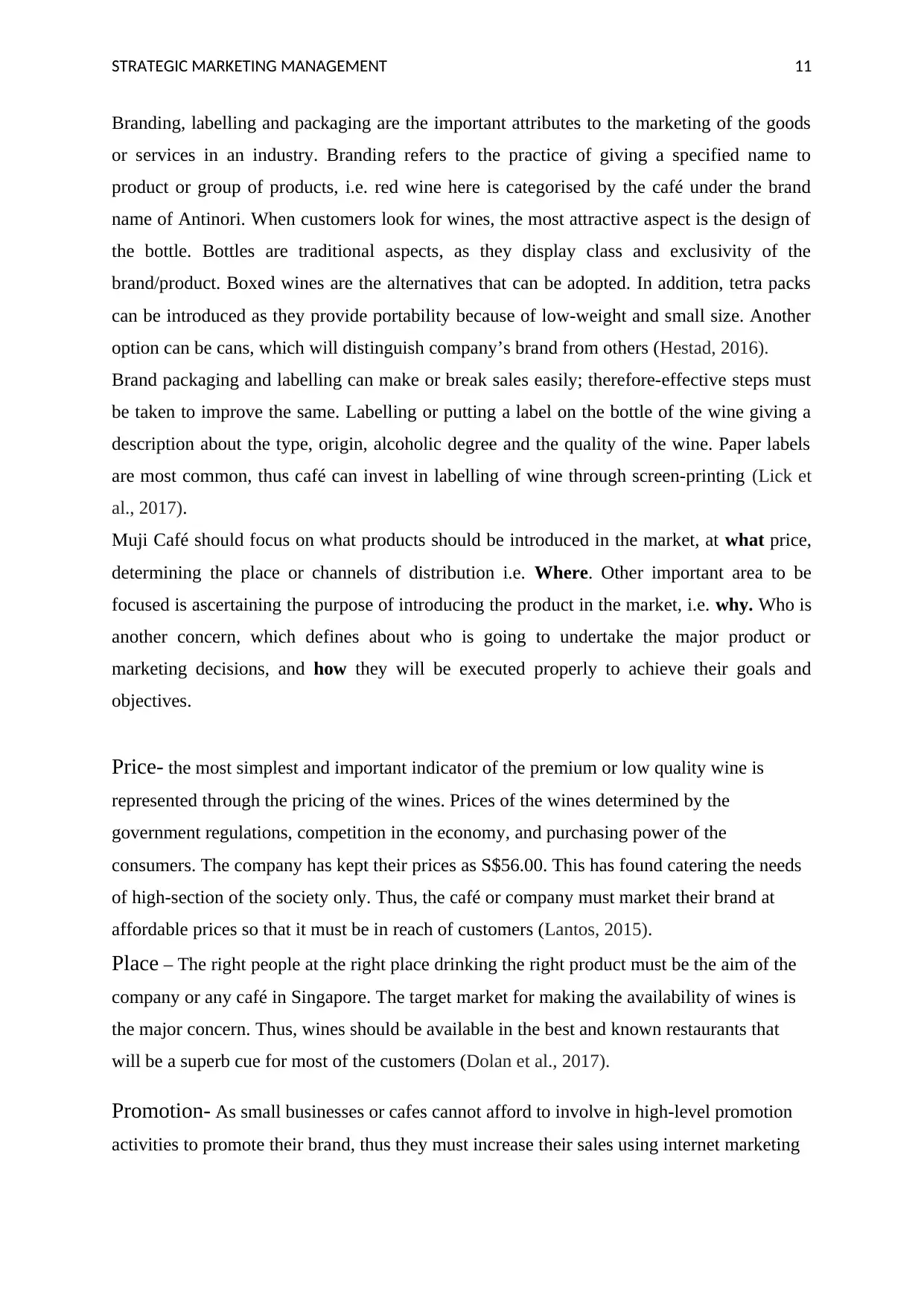
STRATEGIC MARKETING MANAGEMENT 11
Branding, labelling and packaging are the important attributes to the marketing of the goods
or services in an industry. Branding refers to the practice of giving a specified name to
product or group of products, i.e. red wine here is categorised by the café under the brand
name of Antinori. When customers look for wines, the most attractive aspect is the design of
the bottle. Bottles are traditional aspects, as they display class and exclusivity of the
brand/product. Boxed wines are the alternatives that can be adopted. In addition, tetra packs
can be introduced as they provide portability because of low-weight and small size. Another
option can be cans, which will distinguish company’s brand from others (Hestad, 2016).
Brand packaging and labelling can make or break sales easily; therefore-effective steps must
be taken to improve the same. Labelling or putting a label on the bottle of the wine giving a
description about the type, origin, alcoholic degree and the quality of the wine. Paper labels
are most common, thus café can invest in labelling of wine through screen-printing (Lick et
al., 2017).
Muji Café should focus on what products should be introduced in the market, at what price,
determining the place or channels of distribution i.e. Where. Other important area to be
focused is ascertaining the purpose of introducing the product in the market, i.e. why. Who is
another concern, which defines about who is going to undertake the major product or
marketing decisions, and how they will be executed properly to achieve their goals and
objectives.
Price- the most simplest and important indicator of the premium or low quality wine is
represented through the pricing of the wines. Prices of the wines determined by the
government regulations, competition in the economy, and purchasing power of the
consumers. The company has kept their prices as S$56.00. This has found catering the needs
of high-section of the society only. Thus, the café or company must market their brand at
affordable prices so that it must be in reach of customers (Lantos, 2015).
Place – The right people at the right place drinking the right product must be the aim of the
company or any café in Singapore. The target market for making the availability of wines is
the major concern. Thus, wines should be available in the best and known restaurants that
will be a superb cue for most of the customers (Dolan et al., 2017).
Promotion- As small businesses or cafes cannot afford to involve in high-level promotion
activities to promote their brand, thus they must increase their sales using internet marketing
Branding, labelling and packaging are the important attributes to the marketing of the goods
or services in an industry. Branding refers to the practice of giving a specified name to
product or group of products, i.e. red wine here is categorised by the café under the brand
name of Antinori. When customers look for wines, the most attractive aspect is the design of
the bottle. Bottles are traditional aspects, as they display class and exclusivity of the
brand/product. Boxed wines are the alternatives that can be adopted. In addition, tetra packs
can be introduced as they provide portability because of low-weight and small size. Another
option can be cans, which will distinguish company’s brand from others (Hestad, 2016).
Brand packaging and labelling can make or break sales easily; therefore-effective steps must
be taken to improve the same. Labelling or putting a label on the bottle of the wine giving a
description about the type, origin, alcoholic degree and the quality of the wine. Paper labels
are most common, thus café can invest in labelling of wine through screen-printing (Lick et
al., 2017).
Muji Café should focus on what products should be introduced in the market, at what price,
determining the place or channels of distribution i.e. Where. Other important area to be
focused is ascertaining the purpose of introducing the product in the market, i.e. why. Who is
another concern, which defines about who is going to undertake the major product or
marketing decisions, and how they will be executed properly to achieve their goals and
objectives.
Price- the most simplest and important indicator of the premium or low quality wine is
represented through the pricing of the wines. Prices of the wines determined by the
government regulations, competition in the economy, and purchasing power of the
consumers. The company has kept their prices as S$56.00. This has found catering the needs
of high-section of the society only. Thus, the café or company must market their brand at
affordable prices so that it must be in reach of customers (Lantos, 2015).
Place – The right people at the right place drinking the right product must be the aim of the
company or any café in Singapore. The target market for making the availability of wines is
the major concern. Thus, wines should be available in the best and known restaurants that
will be a superb cue for most of the customers (Dolan et al., 2017).
Promotion- As small businesses or cafes cannot afford to involve in high-level promotion
activities to promote their brand, thus they must increase their sales using internet marketing
⊘ This is a preview!⊘
Do you want full access?
Subscribe today to unlock all pages.

Trusted by 1+ million students worldwide
1 out of 16
Related Documents
Your All-in-One AI-Powered Toolkit for Academic Success.
+13062052269
info@desklib.com
Available 24*7 on WhatsApp / Email
![[object Object]](/_next/static/media/star-bottom.7253800d.svg)
Unlock your academic potential
Copyright © 2020–2025 A2Z Services. All Rights Reserved. Developed and managed by ZUCOL.





